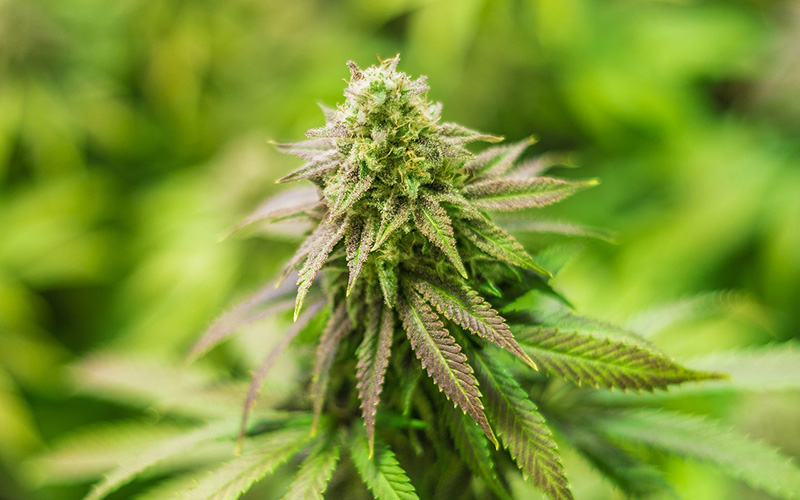Table of Contents [show]

Early Female Preflowers – Spotting early female preflowers is the first sign of the sex of your cannabis plants. In this guide, we’ll explain the importance of this and what to look out for, learn the distinctions between male and female plants, we’ll show you how to pinpoint male preflowers and the earliest time you can determine your plant’s gender. Read on to learn these vital cultivation skills!
What are the first signs of the cannabis preflowering stage?
Before your cannabis plant bursts into the full flowering stage, it shows subtle hints of its gender. Firstly, look for tiny hair-like strands called pistils. These white or creamy-colored hairs emerge at the plant’s nodes, where the branches meet the main stem. You may also notice that your plant’s growth pattern starts to slow down, this is an indication it is about to transition into the flowering phase. Rather than focusing on vertical growth, the plant begins to grow bushier, producing more branches and leaves.
What does week 1 of preflowering look like?
Week 1 of preflowering is all about subtle transformations. Your cannabis plant starts focusing inward, preparing itself for the flowering phase. The most obvious sign during this stage is the growth of small, round nodules where branches intersect with the stem, known as the plant’s nodes. These are the early stages of flower formation. At this point you’ll also notice an increase in the production of trichomes, the tiny, shiny glands on leaves and stems responsible for producing cannabinoids. It’s also common to see an increase in leaf production as the plant builds its energy reserves. By the end of this week, pistils might start peeking out, signaling the start of the flowering stage.
Male vs female marijuana plants: What is the difference?
Understanding the distinction between male and female marijuana plants is important and will make you realize why sexing early is crucial. Female plants are what most growers want, because they produce THC filled flowers that are harvested and then dried and smoked as buds.
On the other hand, male plants primarily serve for breeding purposes. They don’t produce smokable buds. Instead, they grow pollen sacs, small ball-like structures, near their nodes. These sacs release pollen that can fertilize female plants, leading to seed production.
Why is identifying the sex of cannabis so important?
Sexing cannabis plants early is crucial if you are growing with the intent to produce bud. This is because male plants grow pollen sacs and shortly after transitioning to the flowering stage they release pollen that can fertilize female plants, resulting in seeded buds. Once pollinated, the female plants divert their energy to producing seeds which detracts from the overall quality of the bud. For recreational and medicinal users, seedless, or “sinsemilla”, buds are preferred because they have much higher cannabinoid content. By identifying and isolating or removing males from your grow room, before they get a chance to pollinate the female plants ensures that none of your female bud producing plants are compromised. Early sexing also optimizes space and resources, focusing care on productive female plants.
Unless you are planning on breeding your own strains, growing feminized cannabis seeds is probably the best and most effective way of eliminating the risk of pollination. But for those of you that are breeding, or growing regular seeds, sexing is an important skill that you must learn.
How to identify male cannabis preflowers?
Sexing marijuana plants and identifying male preflowers early is skill that all growers need to learn. Even if you grow with feminized seeds, you could occasionally get the odd male or hermie plant slip through the net so its important to understand what you are looking for. Early detection will protect your grow from disaster. During the initial pre-flowering stage, inspect the nodes closely. Here’s what to look for:
Shape: Male preflowers are typically more rounded and develop into small sacs or bulbs. They might resemble tiny grape clusters in their early stage.
Location: These sacs will emerge at the node intersections, where branches meet the main stem. They’re distinctly different from the tear-shaped ovary base of female plants.
Absence of Pistils: Unlike females, male preflowers don’t exhibit hair-like structures (pistils). If you notice any bulbous formation without accompanying pistils, it’s likely male.
What do female preflower buds look like?
Spotting female preflower buds will provide you a good indication that everything is going well and there are no disasters around the corner. These early indicators can provide a sneak peek into the plant’s gender well before the flowering phase kicks in. Here’s what you should observe:
Pistils: The hallmark of a female preflower is the appearance of wispy, hair-like structures known as pistils. They often emerge in pairs and are typically white or pale yellow, protruding from a small tear-shaped calyx.
Shape: Female preflowers have a more conical or tear-drop shape, in contrast to the rounder male preflowers.
Location: Just like male counterparts, female preflowers emerge at the plant’s nodes, where the branch intersects with the main stem.
Size: Initially, female preflowers are tiny, but they gradually grow in size as they develop into mature flowers.
What triggers the cannabis flowering stage?
The shift from vegetative to flowering stage in cannabis is an important part of the cannabis plants life, and several factors play a role in triggering this change:
Light Cycle: The most significant trigger for most cannabis plants is the change in light exposure. As the days become shorter and nights longer, photoperiod cannabis plants naturally enter the flowering stage. In indoor grows, adjusting the light schedule to 12 hours on and 12 hours off typically triggers the plant to enter the flowering phase as it tricks the plant into thinking that winter is coming.
Plant Age: Cannabis plants need to reach a certain level of maturity before they can start flowering. This usually happens after several weeks of vegetative growth. For autoflowers they don’t need a change in light cycle to flower and will transition to the flowering phase at 3-5 weeks old from seed.
Stress: Unexpected factors, like extreme weather conditions, inconsistent light exposure, or physical damage, can sometimes stress a plant into prematurely entering the flowering stage.
How long does the cannabis Preflower stage last?
The cannabis preflower stage gives you an initial insight into a plant’s gender, typically lasting between 1 to 3 weeks. The length of the preflower stage can differ depending on the strain and environmental factors. For instance, Indica strains might have a shorter preflowering phase than Sativas, while autoflowering varieties even shorter still. Additionally, external conditions like light, temperature, and nutrition play a role, with plants in ideal settings possibly transitioning quicker.
What is the earliest you can sex cannabis?
Determining the gender of your cannabis plants early is important, especially if you’re aiming for a seedless harvest. So, when can you start distinguishing males from females?
Age: Typically, cannabis plants show their gender signs a few weeks into the vegetative stage, usually around weeks 4-6. However, this can vary depending on the strain and growth conditions.
Preflower Indicators: Even before full flowering begins, plants will produce preflowers. Female preflowers will display pistils, while male ones exhibit small sac-like structures.
Genetic Testing: A more advanced, yet accurate method is to use genetic testing. By analyzing a young plant’s DNA, usually taken as a tiny leaf sample, you can determine its gender long before any physical signs appear.
Clone Testing: Taking a clone from the plant and forcing it to flower by placing it under a 12/12 light cycle can also help identify its gender.
What are the early signs of a hermie plant?
A “hermie” plant refers to a hermaphroditic cannabis plant, one that develops both male and female reproductive parts. Recognizing a hermie early is vital to prevent unwanted pollination and a potential decrease in the quality of your harvest. Here are the first signs to watch for:
Banana-like Structures: One of the most apparent signs is the emergence of yellow, banana-shaped structures called “nanners.” These are male pollen sacs and often appear amidst the female flowers.
Male Pollen Sacs: In addition to the nanners, hermies might also develop regular male pollen sacs. These are typically round and hang from the plant like tiny balls.
Stress Indicators: While not a direct sign, stress is a common cause for plants turning hermaphroditic. If your plant is showing other symptoms of stress, such as discoloration or wilting, keep a close eye for hermaphroditic signs.
In understanding the importance of sexing cannabis, growers gain a clear edge. Recognizing gender signs early prevents unwanted pollination, ensuring higher potency and quality. By keeping an eye out for male, female, and hermie indicators, you can optimize your next grow for the best results.
Related Articles in Spinfuel:
Weed in Wonderland: Unlocking the Benefits of Cannabis for Restful Sleep




